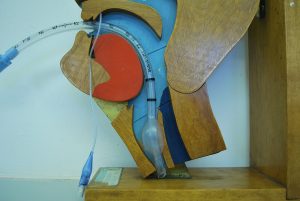Contraindications of Non-Invasive Ventilation
The main contraindications of non-invasive ventilation (NIV) stem from the interface being a tight-fitting mask that does not seal the airway. They include:
- Decreased or altered level of consciousness
- Full stomach/risk of aspiration
- Altered drive to breathe
- Trauma to the face or inability to create a mask seal
If the patient is unable to protect their own airway (by keeping their airway open, coughing or swallowing when needed), they cannot be placed on BiPAP. NIV pushes air into a patient’s upper airway instead of directly into a sealed trachea, like with an endotracheal tube with a balloon to seal. When air is pushed into the upper airway, although most air will go into the lungs, some will go down the esophagus and into the stomach. Air in the stomach increases the risk of vomiting and aspiration. Aspiration is when vomit or stomach contents come up into the oropharynx and fall into the respiratory tract, ending up in the lungs. Patients on NIV are at high risk of aspirating vomit or other foreign objects.
NIV therapies are delivered via a tight-sealing face mask instead of an endotracheal tube that passes through the cords. An endotracheal tube (ETT) is able to create a perfect seal by way of passing through the cords, while an ETT cuff is inflated that seals off the trachea.

Conversely, a mask interface—though normally secured very tightly to the face, is not a perfect seal. There are always small gaps, and any movement of the face can cause leaks. Another critical concept is that the mask does not allow for complete “protection” of the airway. The trachea is not closed off and is in communication with the oropharynx, but it would be sealed off with the cuff on an endotracheal tube (ETT) if one was in place.
This open communication between the esophagus and the trachea when using NIV and a mask interface is the main concern, as the application of pressure will push vomit/stomach contents down into the lungs if the mask is kept in place when a patient vomits. Risk of aspiration is very high with non-invasive therapy. If the patient vomits while NIV is in place, aspiration is almost unavoidable. Non-invasive ventilation is not indicated with altered level of consciousness since it (a) can impact the patient’s gag reflex, and (b) may impact their ability to remove the mask if they feel they need to vomit. Since aspiration is such a large concern with NIV, this therapy is not used on patients with full stomachs, and patients are usually fasted while using this therapy.
An altered drive to breathe is also an issue with NIV. BiPAP only can be used to augment spontaneous breaths that the patient is already triggering. It cannot deliver a manual breath, as it is not a sealed system. If the patient is not reliably breathing on their own, they cannot be put on NIV. Two classic examples of inappropriate drive to breathe include agonal respirations or a neurologic injury that disrupts spontaneous breathing.
Inability to create an effective mask seal is a major concern with non-invasive ventilation. We have already discussed about the issue with leaks and the need for a tight seal with non-invasive interfaces. When air is pushed into a patient’s nose and mouth through a mask, it is mandatory that a tight seal is created. Any situation that would impact the ability of the mask to seal on the patient’s face will be an issue. Any facial trauma that would render a mask seal inadequate or that can be damaged by a tight sealing mask can make a patient unsuitable. Even beards, small chins or large noses can pose difficulties in creating a tight seal. Also, bleeding in the upper airway or trauma to the upper airway that would necessitate the bypassing of the upper airway would necessitate endotracheal intubation.

Media Attributions
- ETT © Dr. Lorimer is licensed under a CC BY-SA (Attribution ShareAlike) license
- Facial Trauma © U.S. Army photo by Sgt. Jessi McCormick/Released

